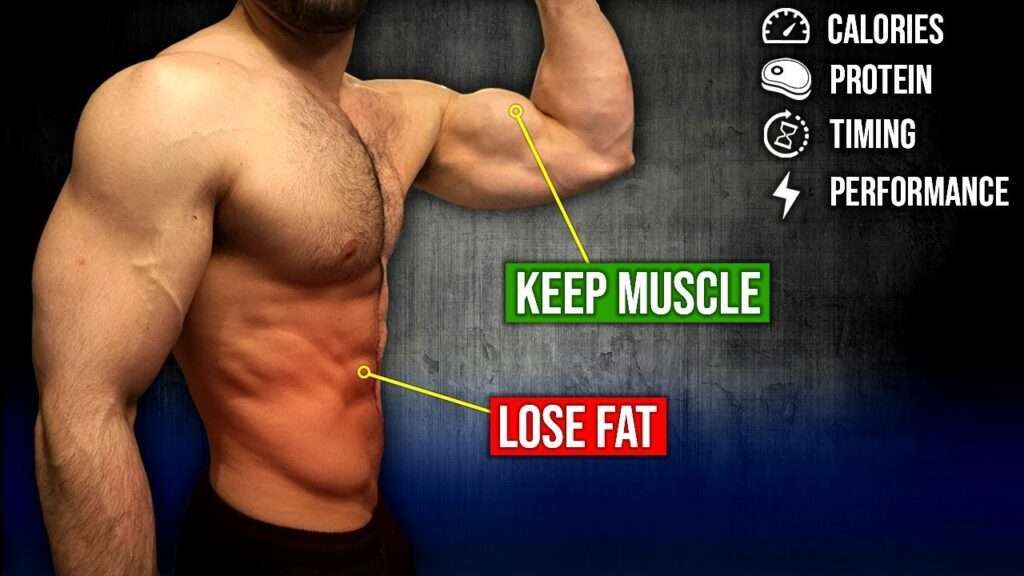It’s a question that has plagued many, confounded countless, and left even the most dedicated fitness enthusiasts scratching their heads in frustration. You’ve decided to embark on a weight loss journey, but you’re concerned – rightfully so – about losing that hard-earned muscle in the process. Fret not, dear reader, for the solution may not be as elusive as you once thought.
In this thought-provoking article, we will explore the delicate balance between shedding unwanted pounds while preserving precious muscle mass. You’ll discover the science-backed strategies, expert tips, and actionable steps to ensure that your weight loss journey is not only effective but also muscle-friendly. So, buckle up and set aside your doubts, because we’re about to unlock the secrets of how you can achieve your dream physique without sacrificing your hard-earned gains.

Understanding Caloric Deficit
What is a caloric deficit?
A caloric deficit is a concept that involves consuming fewer calories than your body needs to maintain its current weight. In other words, you are creating a shortage of energy, which forces your body to utilize stored fat as a source of fuel. When you consistently maintain a caloric deficit over time, it can result in weight loss.
The importance of a caloric deficit for weight loss without muscle loss
When attempting to lose weight, it is crucial to ensure that the weight loss primarily comes from fat and not muscle. Losing muscle mass can lead to a slower metabolism and a less toned physique. By implementing a caloric deficit while focusing on preserving muscle mass, you can achieve sustainable weight loss without compromising your muscle gains.
Determining your ideal caloric deficit
To determine your ideal caloric deficit, you need to calculate your basal metabolic rate (BMR) – the number of calories your body requires at rest to maintain its current weight. Several online calculators can help estimate your BMR based on factors like gender, age, weight, and height. Once you have your BMR, you can subtract a certain number of calories to create your caloric deficit. A safe and sustainable approach is to aim for a deficit of 500-1000 calories per day, which typically results in a weight loss of 1-2 pounds per week.
Implementing a Balanced Diet
Meeting protein requirements
Protein is an essential nutrient for building and maintaining muscle mass. To prevent muscle loss during a caloric deficit, it is crucial to meet your protein requirements. The recommended daily protein intake for individuals engaged in regular physical activity is around 0.8-1 gram per pound of body weight. Incorporating lean sources of protein such as chicken, fish, tofu, eggs, and legumes into your meals and snacks can help you meet your protein needs and support muscle maintenance.
Managing carbohydrate intake
Carbohydrates provide your body with energy, but excessive carb consumption can impede weight loss. When implementing a caloric deficit, it is important to manage your carbohydrate intake. Choose complex carbohydrates like whole grains, fruits, and vegetables that are rich in fiber and provide sustained energy. Avoid refined and processed carbohydrates like white bread, sugary snacks, and sodas, as they can lead to blood sugar spikes and hinder weight loss efforts.
Incorporating healthy fats
Contrary to popular belief, consuming healthy fats is important for weight loss and overall health. Fats are necessary for hormone production, nutrient absorption, and satiety. Opt for sources of healthy fats such as avocados, nuts, seeds, olive oil, and fatty fish like salmon. These fats can help keep you feeling satisfied and support your body’s various functions while on a caloric deficit.
Including a variety of fruits and vegetables
Fruits and vegetables are packed with essential vitamins, minerals, and fiber, making them crucial components of a well-balanced diet. They not only provide vital nutrients but also contribute to feelings of fullness and satiety, helping you stay on track with your caloric deficit. Aim to incorporate a variety of colorful fruits and vegetables into your meals and snacks to ensure you are getting a wide range of nutrients and antioxidants.

Strategizing Exercise Routine
Resistance training to maintain muscle mass
One of the best ways to preserve muscle mass during a caloric deficit is through resistance training. Lift weights or use resistance bands to challenge your muscles, stimulating them to grow and adapt. Regular strength training exercises should target all major muscle groups, focusing on compound movements like squats, deadlifts, and bench presses. By engaging in resistance training, you signal to your body that muscle maintenance is a priority, helping to minimize muscle loss while losing weight.
Incorporating cardiovascular exercises for calorie burn
Cardiovascular exercises are effective for burning calories and aiding weight loss. Incorporate activities like running, cycling, swimming, or brisk walking into your routine to increase your calorie expenditure. While cardio exercises primarily target fat loss, they can also help maintain muscle mass when combined with resistance training. Aim for 150 minutes or more of moderate-intensity cardio each week to support your weight loss goals and overall health.
Balancing intensity and duration of workouts
Finding the right balance between intensity and duration of workouts is essential when losing weight without losing muscle. High-intensity interval training (HIIT) is a popular method that combines short bursts of intense exercise with periods of active recovery. This type of workout can be particularly effective for burning calories and preserving muscle mass. However, it is important to listen to your body and allow for adequate rest and recovery between sessions to prevent overtraining and potential muscle loss.
Prioritizing Protein Intake
Understanding the role of protein in muscle maintenance
Protein plays a crucial role in muscle maintenance and repair. It is composed of amino acids, which are the building blocks of muscle tissue. During a caloric deficit, providing an adequate amount of protein helps prevent your body from breaking down muscle for energy. By prioritizing protein intake, you ensure that your body has the necessary resources to preserve muscle mass while losing weight.
Calculating protein requirements
Calculating your protein requirements accurately is essential to support muscle maintenance during a caloric deficit. As mentioned earlier, the recommended daily protein intake ranges from 0.8-1 gram per pound of body weight for physically active individuals. For example, if you weigh 150 pounds, you should aim for 120-150 grams of protein per day. Keep in mind that individual needs may vary based on factors such as activity level, body composition, and goals.
Incorporating high-quality protein sources
Choosing high-quality protein sources is crucial for meeting your protein requirements and supporting muscle maintenance. Opt for lean sources of protein, such as chicken, turkey, lean cuts of beef or pork, fish, tofu, tempeh, Greek yogurt, cottage cheese, and plant-based protein powders. These sources provide essential amino acids while being relatively low in fat and calories.
Spacing out protein intake throughout the day
Rather than consuming all your protein in one or two meals, it is beneficial to distribute your protein intake evenly throughout the day. Spacing out your protein consumption allows for better absorption and utilization of amino acids by your muscles. Aim to include a source of protein in every meal and snack, helping to optimize muscle maintenance while creating a caloric deficit.

Monitoring Nutrient Timing
Pre- and post-workout nutrition strategies
Optimizing your nutrient timing around your workouts can enhance muscle preservation during a caloric deficit. Consuming a combination of carbohydrates and protein before your workout can provide readily available energy and help prevent muscle breakdown. After your workout, consuming a protein-rich meal or snack within the first few hours helps stimulate muscle protein synthesis, promoting muscle repair and growth.
Optimizing nutrient timing for muscle preservation
Even outside of workouts, paying attention to nutrient timing can support muscle preservation. Eating regular meals and snacks throughout the day helps provide a steady supply of nutrients to your muscles, reducing the risk of muscle breakdown. Additionally, consuming a protein-rich meal or snack before bed can help prevent muscle breakdown during the overnight fasting period.
Managing Stress and Sleep
Impact of stress on weight and muscle loss
Stress can have a significant impact on weight and muscle loss. Elevated stress levels can lead to increased cortisol production, which can promote fat storage and muscle breakdown. To prioritize muscle maintenance during a caloric deficit, it is important to manage your stress levels effectively.
Strategies to reduce stress levels
Implementing stress-management strategies can help mitigate the negative effects of stress on weight and muscle loss. Engage in activities such as meditation, deep breathing exercises, yoga, or engaging hobbies to promote relaxation and reduce stress. Additionally, ensuring you have a support system in place, seeking therapy or counseling, and practicing self-care can all contribute to reducing stress levels.
Importance of quality sleep for weight and muscle maintenance
Quality sleep is crucial for weight and muscle maintenance. Lack of sleep can disrupt hormone production, increase appetite, and negatively impact muscle recovery. Aim for 7-9 hours of uninterrupted sleep each night to support your weight loss and muscle preservation goals. Establishing a consistent sleep schedule, creating a sleep-friendly environment, and practicing good sleep hygiene can all contribute to getting adequate rest for optimal results.
Tracking Progress and Adjustments
Setting realistic goals
Setting realistic goals is important when embarking on a weight loss journey without losing muscle. Understand that sustainable weight loss takes time and patience. Aim for a gradual, steady weight loss of 1-2 pounds per week, as this allows you to preserve lean muscle mass and minimize the risk of regaining the weight.
Monitoring body composition changes
Tracking changes in your body composition can provide valuable insights into your progress. Utilize methods such as body measurements, progress photos, or body fat percentage assessments to assess changes beyond the number on the scale. Remember that muscle is denser than fat, so improvements in body composition may not always be reflected in weight loss alone.
Making adjustments based on progress
As you progress on your weight loss journey, it may be necessary to make adjustments to your caloric deficit, exercise routine, or macronutrient distribution. Consulting with a registered dietitian or nutritionist can help ensure you are making the appropriate adjustments based on your individual needs and goals. They can provide personalized guidance to help you continue losing weight without losing muscle.
Seeking Professional Guidance
Working with a registered dietitian or nutritionist
Working with a registered dietitian or nutritionist can be highly beneficial when aiming to lose weight without losing muscle. These professionals can assess your individual needs, provide personalized meal plans, monitor your progress, and offer guidance and support throughout your journey. They can also help address any specific dietary concerns you may have and ensure that you are meeting all nutritional requirements while creating a caloric deficit.
Consulting a personal trainer or exercise specialist
Consulting a personal trainer or exercise specialist can also be valuable when designing an exercise routine that supports muscle preservation during a caloric deficit. These professionals can assess your current fitness level, help create a tailored workout plan, provide proper form guidance, and offer advice on optimizing your exercise routine for maximum results. Their expertise can prevent injury and ensure you are targeting the right muscle groups to support your weight loss goals.
Being Consistent and Patient
Emphasizing the importance of consistency
Consistency is key when it comes to losing weight without losing muscle. Progress takes time and dedication, so remaining consistent with your caloric deficit, exercise routine, and overall lifestyle choices is essential. Remember that small, sustainable changes over time lead to long-term success. Stay committed, stay positive, and remind yourself of the benefits you will reap by staying consistent on your journey.
Understanding the time frame for sustainable weight loss without muscle loss
It is important to have realistic expectations when embarking on a weight loss journey without losing muscle. Sustainable weight loss typically occurs at a rate of 1-2 pounds per week, although individual results may vary. Keep in mind that everyone’s body is different, and factors such as genetics, metabolism, and overall health can influence the speed at which you see progress. Focus on making sustainable lifestyle changes and trust the process, knowing that slow and steady progress will yield lasting results.
In conclusion, losing weight without losing muscle is achievable with the right strategies and mindset. Implementing a caloric deficit, focusing on a balanced diet, strategizing your exercise routine, prioritizing protein intake, monitoring nutrient timing, managing stress and sleep, tracking progress and making adjustments, seeking professional guidance when needed, and maintaining consistency and patience are all key factors in successful weight loss. By following these guidelines and making sustainable lifestyle changes, you can reach your weight loss goals while preserving your hard-earned muscle mass and achieving a healthier, more balanced body.
